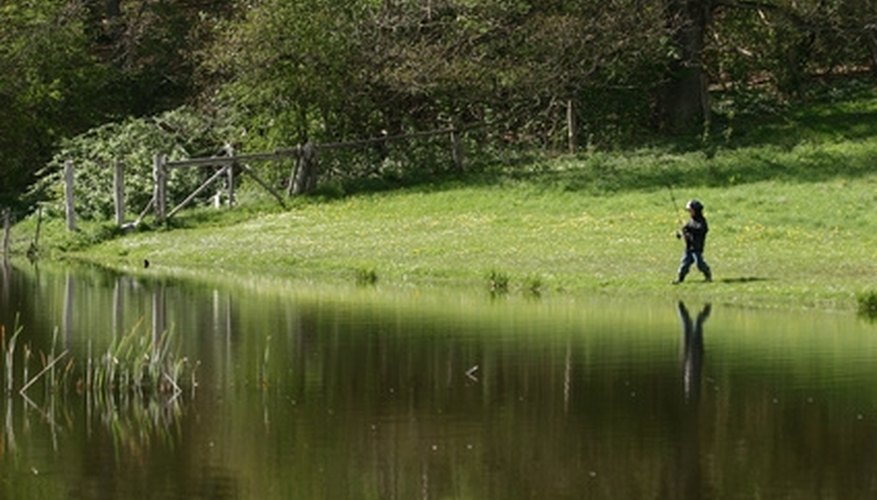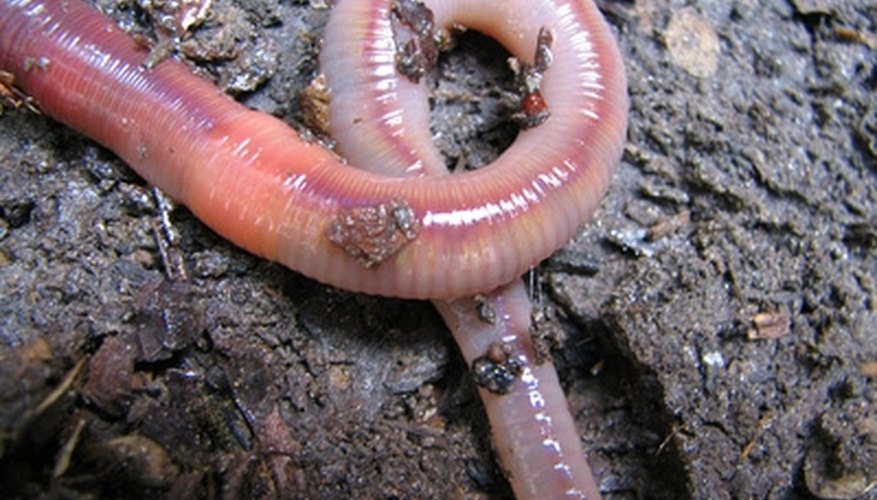
Bluegill and bass eat many of the same things with bass being a little more selective, not to mention aggressive. Bluegill will either eat or peck nearly anything that falls in front of them, while bass must often be tricked into taking your bait. There is one dominant bait for these species, but there are a few alternatives.
Worms

worm image by Ksenija Djurica from Fotolia.com
Nightcrawlers, red worms and mealworms are the top baits for bass and bluegill. Nightcrawlers, whether fished whole or cut in half, will be the top offering for bass species. Big bass will hit a full nightcrawler on the move or resting on the bottom. Keep it fresh. Smaller-cut pieces, from 1/8- to 1/2-inch, are the best bet for bluegill. A small bait hanging below a bobber is usually more than a bluegill can resist.
Red worms will be deadly for smaller bass and bluegill. They are ideal with great movement in the water and smaller for the fish's tiny mouths. They require a smaller hook for rigging.
Mealworms are a top choice for bluegill. Bass will also eat these small worms, but bluegill, perch or red ear, whatever you call them in your region, can't resist this tough worm. Also works paired with a jig.
Bugs

cricket or grasshopper image by Marek Kosmal from Fotolia.com
Bugs, both microscopic, subsurface species and larger airborne insects, are a major part of the bass and bluegill diet. Mosquitoes, dragonflies and damsel nymphs are on the menu, but good luck getting one on your hook. That's why a beefy grasshopper or cricket is a popular option for bass and bluegill.
These bugs can be found in pond-side grass or at a local tackle shop. They are deadly when alive on the surface or even if they are dead with a little twitch. The movement of a grasshopper or cricket on the surface will attract fish from all around. The trick is to cast it far enough to avoid spooking fish close to shore. Try a bobber for extra weight to aid with casting or try a tiny weight and fish it under the surface.
Unconventional Baits

hot dog and fries image by Ray Kasprzak from Fotolia.com
Minnows and other aquatic species also make great baits. Bass and bluegill both prey on smaller fish so it is always tempting to use minnows and fry for bait, but many lakes don't allow the use of rough fish minnows. There are two reasons this is illegal in many areas. First, anglers can't use baby gamefish for bait because it hurts the population, and if you used, say, a goldfish, domestic or non-native fish can have an impact on the fishery should they swim free from your hook.
Check local regulations, but if the use of minnows, waterdogs or crawfish is allowed, you'll quickly turn the heads of the biggest bass in the vicinity. Crawfish are typically allowed as bait in most areas. Many bass on the top 15 largemouth bass of all time list were taken on live crawfish. Lots of the fish from California's Lake Castaic were taken on crawdads.
Bluegill aren't the minnow eaters like bass, but they too will eat tiny fish if given the chance. They will hit nearly anything in their vision if it is small enough. They will hit a bare hook or a small piece of everything from your barbecue. They love hot dog skin, bread or anything else you can get on a hook. Drop the offering in front of them and they will fight over the meal.
References
Writer Bio
Perched atop the Mile High City, Brian La Rue has written outdoor-related articles since 1999. His features have appeared in magazine's including "Western Outdoors," "Fishing & Hunting News" and "High Country Angler." His work can be seen on "ESPN Outdoors." He holds a bachelor's in communications from Cal State Fullerton.



